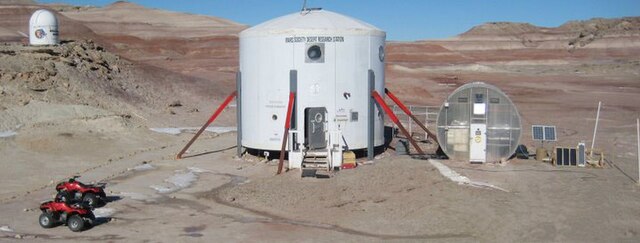Mars Desert Research Station
The Mars Desert Research Station (MDRS) is the largest and longest-running Mars surface research facility and is one of two simulated Mars analog habitats owned and operated by the Mars Society.
The Mars Society's Mars Desert Research Station located near Hanksville, Utah
Crew 73 members in Space Suit Simulators
MDRS
Crew 73 meets with writer Laurie Schmidt upstairs in the Hab.
A Mars analog habitat is one of several historical, existing or proposed research stations designed to simulate the physical and psychological environment of a Martian exploration mission. These habitats are used to study the equipment and techniques that will be used to analyze the surface of Mars during a future crewed mission, and the simulated isolation of the volunteer inhabitants allows scientists to study the medical and psychosocial effects of long-term space missions. They are often constructed in support of extensive Mars analogs. However, sometimes existing natural places are also valued as Mars analogs. Crewed Mars habitats are featured in most human Mars missions; an alternative may be terraforming or telepresence.
The FMARS hab in 2009
The Mars Society's Mars Desert Research Station
The BYU Mars Rover undergoing field tests at the Mars Desert Research Station.







